

How NASA is rehearsing for a mission to Mars. "Astronauts” hike up the side of a Hawaiian volcano on a simulated mission to Mars.

(Zena Cardman) The Martian landscape is otherworldly. The ground is twisted into ropelike coils, rippling waves and jagged spikes; sulfurous gases billow from vents in the ground, bits of volcanic glass glitter in faint sunlight that filters through the undulating fog. Two astronauts clamber across the tortured terrain, encumbered by the heavy scientific instruments they carry on their backs and in their hands. They are looking for rocks that could tell us whether life ever existed on Mars. At makeshift mission control inside a converted conference room several miles away, Darlene Lim surveys video from the scene. “This is super awesome,” Lim murmurs under her breath. This landscape, of course, is not actually Mars, and the people exploring it aren't really astronauts. [After a year pretending to be on Mars, NASA's 'astronauts' are back home] Who Will Save Your Life on Mars? Experiences not Courses. Roger Schank. In 1989, I witnessed corporate training for the first time.

We had just started the Institute for The Learning Sciences, which was sponsored by Andersen Consulting (now Accenture). I visited their campus in St. Charles, Illinois, and saw many classrooms full of people who were mostly half asleep or in a daze from being talked at about corporate culture, and Andersen’s core values, and client needs, and so on.
But, they had spent a lot of money on me so they were willing to listen. Early on, they said we could redo any course they offered there except one, which was the entry-level boot camp. I saw immediately why they loved it. I have had plenty of opportunity to look at corporate training since then, and my team and I have built quite a bit of it. Some things to stop doing: 1. Content cannot be delivered. What needs to be "delivered" are dialogues with individuals. But we keep talking at people. Now I need to be careful here because my customers think we create courses for them. Roger Schank. Roger Schank. Flashline Mars Arctic Research Station - Wikipedia. The Flashline Mars Arctic Research Station (FMARS) is the first of two simulated Mars habitats (or Mars Analog Research Stations) established and maintained by the Mars Society.
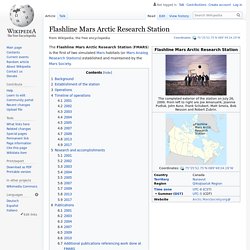
Background[edit] Devon Island and surroundings. Haughton crater also shown The station is located on Devon Island, a Mars analog environment and polar desert, approximately 165 kilometres (103 mi) north east of the hamlet of Resolute in Nunavut, Canada. The station is situated on Haynes Ridge, overlooking the Haughton impact crater, a 23 km (14 mi) diameter crater formed approximately 39 million years ago (late Eocene).[1] The location is approximately 1,609 km (1,000 mi; 869 nmi) from the Geographic North Pole and approximately 1,287 km (800 mi; 695 nmi) from the Magnetic North Pole.
FMARS is the first research station of its kind to be built, completed in the summer of 2000. The project's final cost was US$1.3 million, raised through sponsorships with major companies. Mars Desert Research Station - Wikipedia. The Mars Society's Mars Desert Research Station The Mars Desert Research Station (MDRS) is the second of four planned simulated Mars surface exploration habitats (or Mars Analogue Research Stations) owned and operated by the Mars Society.
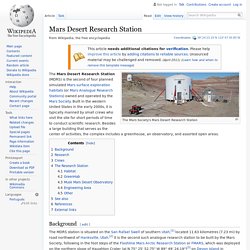
Built in the western United States in the early 2000s, it is typically manned by small crews who visit the site for short periods of time to conduct scientific research. Besides a large building that serves as the center of activities, the complex includes a greenhouse, an observatory, and assorted open areas. Background[edit] Mars analog habitat - Wikipedia. A Mars analog habitat is one of several historical, existing or proposed research stations designed to simulate the physical and psychological environment of a Martian exploration mission.
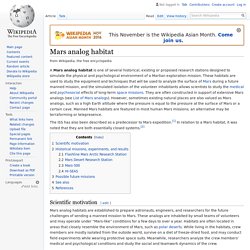
These habitats are used to study the equipment and techniques that will be used to analyze the surface of Mars during a future manned mission, and the simulated isolation of the volunteer inhabitants allows scientists to study the medical and psychosocial effects of long-term space missions. They are often constructed in support of extensive Mars analogs (see List of Mars analogs).
However, sometimes existing natural places are also valued as Mars analogs, such as a high Earth altitude where the pressure is equal to the pressure at the surface of Mars or a certain cave. Manned Mars habitats are featured in most human Mars missions; an alternative may be terraforming or telepresence. Scientific motivation[edit] Historical missions, experiments, and results[edit]
Scientists Pretend to Live on Mars in the Utah Desert. Mars Desert Research Station MDRS Crew 165 Highlight Video. Crew 164 Mid-Rotation Video. European Mars Analog Research Station - Wikipedia. Researchers training in Hawaii to simulate Mars mission - Blogs. HILO, Hawaii -- Scientists will mix biology and geology this month inside Hawaii Volcanoes National Park as they help NASA get ready for an eventual manned mission to Mars.
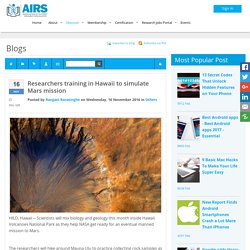
The researchers will hike around Mauna Ulu to practice collecting rock samples as they would on the Red Planet, The Hawaii Tribune-Herald reported Friday. The purpose is to develop protocols that would be used on a real Mars mission to identify and protect samples that could host life. One of the concerns is contamination of rocks that might be home to living bacteria, said John Hamilton, an astronomy faculty member at the University of Hawaii at Hilo. "Really, the whole reason of going to Mars is to see if there's life there," he said. Advertisment "There's a lot of great geology. The project is known as BASALT -- or Biologic Analog Science Associated with Lava Terrains. Hamilton said NASA selected Hawaii, along with the Snake River plain in Idaho, as research sites because they both host volcanic terrain similar to Mars. What Is Antarctica? This picture of Earth is sometimes called the Blue Marble.
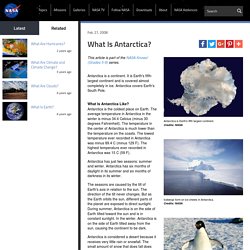
Credits: NASA The tilt of Earth causes seasons. NASA has more than a dozen Earth science satellites in orbit. They help NASA study the oceans, land and air. NASA studies our planet to find ways to take care of it. Legendary Astronaut Buzz Aldrin Medically Evacuated From Antarctica. The U.S.
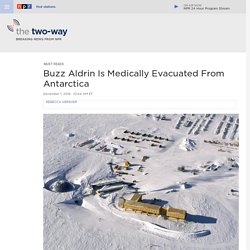
Amundsen-Scott South Pole Station in Antarctica as seen in 2002. David McCarthy/AFP/Getty Images hide caption toggle caption David McCarthy/AFP/Getty Images The U.S. Buzz Aldrin, who walked on the surface of the moon with Neil Armstrong in 1969, is being medically evacuated from the South Pole, the National Science Foundation says. Aldrin, 86, was visiting Antarctica as part of a tourist group.
A second Tweet showed Aldrin and a group of about a dozen travelers whom he referred to as "Buzz's Polar Penguins. "